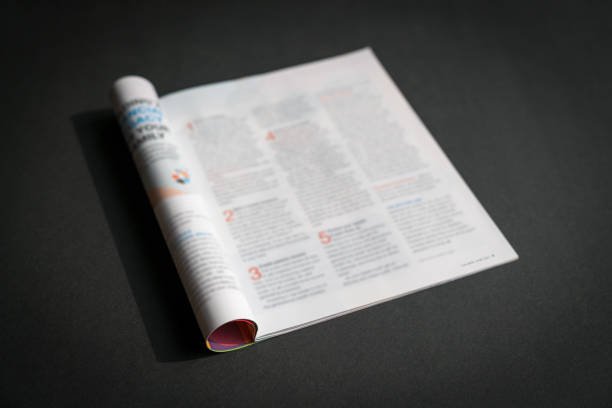
In Australia, startups are seeing how print magazines help their brand stand out. Magazine printing is a smart way to get noticed, engage people, and leave a strong memory. If you’re starting a new one or refreshing an old project, good printing plans can really help your business.
MVP Print stands out in Australia for magazine printing. They use top-notch tools and a skilled team to get your magazine looking its best. You can bring your own designs to print, or they can help create artwork for you. They’re fast too, often printing within 24 hours. MVP Print offers cheap magazine printing, providing cost-effective solutions without compromising on quality.
MVP Print goes above and beyond in every part of printing your magazine. They offer different ways to get your magazines where they need to go. You can choose from various binding types, like saddle stitch or perfect bound. Whatever you need, MVP Print knows how to make it happen.
They also give you lots of choices for the type of paper your magazine gets printed on. You might want coated, uncoated, or even recycled paper. They have it all, helping your magazine look just as you imagine. This is key to make your magazines really grab attention.
For startups wanting to break into the magazine world, MVP Print is a great choice. They offer high-quality yet affordable print services. With their help, and their advanced technology, you can turn your ideas into a magazine that really shines. It’s a great way to connect with your audience and get noticed in Australia.
Magazines to Print ? A Comprehensive Solution
MVP Print dares to make your content stand out as a leading magazine printing company offering comprehensive solutions. Their work is like crafting a masterpiece for you. They use the best equipment and a talented team to get it right every time.
Precision: State-of-the-Art Equipment and Expertise
At MVP Print, they push the boundaries with tech and know-how. This means your project always gets the quality it deserves. Their gear and team of print experts promise top-notch results.
Design: Assistance or Print-Ready Files
Need to design from scratch or have your designs ready? MVP Print has you covered. They can assist with creating a professional cover design for your magazine, including the back cover, spine, and front cover design. Their design team can turn your ideas into reality. Or, they can just print what you’ve already designed.
Express: Fast and Reliable Printing when choosing which Magazines to Print
Speed and trust are what MVP Print is all about. They’ll often get your magazines done in less than a day. Their quickness and reliability are simply unmatched.
Distribution: Reach Customers or Partners
Once your mags are done, MVP Print can help get them to your readers or partners. They’re as skilled in delivery as they are in printing. Quality and care remain their top priorities even after printing.
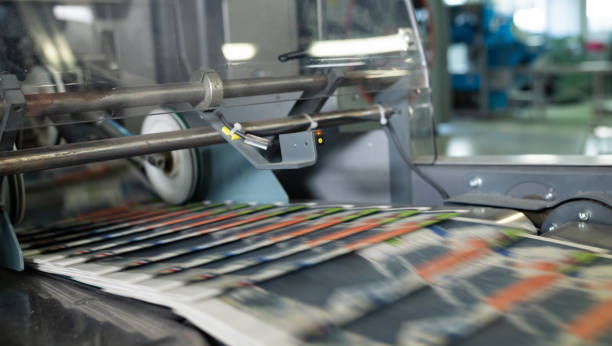
Size Options for when Selecting which Magazines to Print
There’s a big variety of sizes for magazines, each one fitting different needs. The standard A4 size (210x297mm) is a top pick. It works well for many types of content. The digest size (148x210mm) is smaller and often saves money.
A4 and A5
A4 (210 x 297 mm) and A5 (148 x 210 mm) are known everywhere. They offer a good balance for mixing words with pictures.
Square and Tabloid Sizes
Square ( 210 x 210 mm) magazines are great for visual arts. They suit art and design work well. Tabloid (279mm x 430mm ) is larger. It’s good for big projects like portfolios and photography.
Slim Jim and Mini Sizes
Slim Jim (101 x 228 mm) and pocket-sized (89x127mm or smaller) magazines are little and lively. They are perfect for handouts or small ads.
Oversized and Custom Sizes
Oversized magazines (305 x 381mm or bigger) are hard to miss. They’re used for big projects or standout issues. Some places also create custom sizes for you.
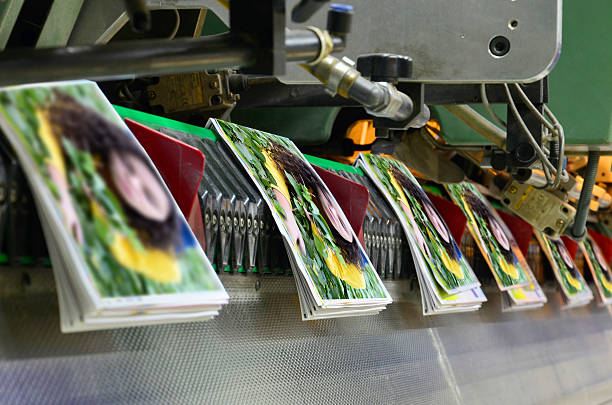
Binding for Magazines to Print Options
Choosing the right binding for a magazine can really change how it looks and works. There are many ways to bind a magazine, each with its own benefits. Perfect bound magazines, for example, use a hot melt glue to create a more appealing and book-shelf quality presentation with a polished, flush edge. These can meet various needs and costs.
Hot melt glue plays a crucial role in perfect bound magazines, ensuring a polished, appealing presentation with a clean, flush edge.
Saddle-Stitch Binding
Saddle-stitch binding is common and budget-friendly, with saddle stitched booklets being a popular option. Saddle stitched magazines are also suitable for various types of content such as product manuals, community magazines, and art books. Pages are folded in half and stapled at the spine. It’s great for magazines with fewer pages, like newsletters and brochures.
Perfect Binding
Perfect binding gives magazines a sleek and professional finish. It involves gluing the pages together along the spine. This is used for magazines with more pages. It offers a durable and neat look.
Wire-O and Spiral Binding
Wire-O binding uses metal wires for a flat lay when open, perfect for calendars. Spiral binding uses coils for a flexible operation, ideal for cookbooks and notebooks.
Case Binding (Hardcover)
Case binding, or hardcover, glues pages into a sturdy cover. It’s for top-quality or collector’s magazines. It adds an elegant touch.
Side-Stitch Binding
In side-stitch binding, pages are stapled on the side, not the spine. It’s unique and suits creative magazines. It has a special look and feel.
Paper Types when choosing which Magazines to Print
The paper type you choose for a magazine matters a lot. It changes how the magazine looks, feels, and how easy it is to read. There are various paper stocks available for magazine printing, including options with gloss, matte, or satin finishes.
Additionally, you can choose from different paper weights, ranging from 60# text to 100# cover, to suit the type of magazine you are creating. Coated paper is smooth and shiny, perfect for showing colours well. It’s often in high-end magazines, fashion ones, or those with lots of photos. You can pick from gloss, matte, or satin finishes.
Coated Paper (Gloss, Matte, Satin)
Magazines often use coated paper for its ability to make images and colours stand out. Glossy magazines use this paper for its attractive surface and protection against moisture.
Uncoated Paper
Uncoated paper feels more natural and is great for stories, art magazines, or those with a classic look. It’s perfect for pages full of text and it’s good for the earth too.
Recycled Paper
Using recycled paper for magazines is a trend that’s good for the planet. It comes in matte or uncoated finishes. This choice shows the publisher cares about the environment.
Textured Paper
Linen, laid, or felt textures make magazines feel more special. Magazines with unique paper stand out, even in a world of digital media.
Newsprint and Coated Recycled Paper
Newsprint is light and cost-efficient, usually used for inner pages. Coated recycled paper blends eco-friendliness with a polished look.
High-Quality Art Paper and Laminated Paper
Art paper or laminated finishes are for magazines that want to be top-notch. They make a magazine feel more valuable and lasting. This often attracts more readers and advertisers.
Metallic or Foil Paper and Translucent Paper
Metallic or translucent papers can make magazine covers or pages unforgettable. They give a luxurious touch, staying in readers’ minds.
Text and Cover Stock
100# gloss text is good for inside pages and 80-100# gloss cover for the outside. The choice between matte and glossy depends on what the readers like and the content’s style.
Glossy Card stock
Glossy card stock is great for covers, making them feel premium and durable. Magazines with high-quality covers are more attractive to advertisers and readers, increasing their value.
Paper GSM for Magazines to Print
Choosing the right paper GSM is crucial for magazine printing. It impacts the publication’s weight, thickness, and feel. The correct paper weight enhances a magazine’s quality, durability, and visual appeal.
Thin Paper (35-55 GSM)
Thin paper, between 35-55 GSM, is for newspapers and budget magazines. It’s affordable and flexible but can be a bit see-through. This might lower the magazine’s readability and image quality.
Standard Paper (60-90 GSM)
Standard paper falls within 60-90 GSM and is perfect for magazines with many pages. It strikes a good balance between cost, weight, and quality. Many publishers choose this for their magazines.
Text Weight Paper (100-120 GSM)
Text weight paper, from 100-120 GSM, is a bit heavier than standard. It’s great for magazines that focus on being easy to read and good to look at. This weight makes the magazine feel more substantial and look better.
Cover Weight Paper (150-250 GSM)
Cover weight paper, 150-250 GSM, is even thicker and tougher. It’s best for magazine covers. This paper makes the magazine durable and gives it a premium touch. Your magazine will stand out more because of it.
Heavyweight Paper (260-350 GSM)
If you’re creating a high-end or special magazine, consider heavyweight paper. It ranges from 260-350 GSM and is incredibly thick and strong. It makes your magazine feel exceptionally high-quality, withstands lots of ink, and leaves a lasting impression on readers.
Magazines to Print: Overview of Printing Processes
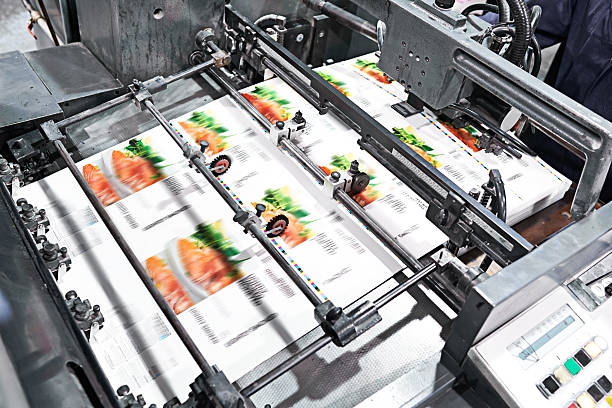
Printing a magazine involves several steps to make a top-notch product. Knowing these steps helps pick the right printing approach for your project. Booklet printing includes various aspects such as different binding methods, paper types, fast turnaround times, and specific printing options like saddle-stitched booklets and black and white printing. Templates and customization options are also available to meet specific printing needs.
For a magazine printing project, proofing is crucial. Opting for a hard copy proof ensures the job is printed correctly.
The first step is to get your design files ready. You need to make sure your text and pictures look great on the paper you choose. This might mean working with a graphic designer. You could also use programs like Adobe InDesign or Illustrator to make a sleek design.
Next, you choose how to print your magazine. Offset printing is great if you need a lot of copies. It gives sharp, consistent quality. For smaller print jobs, digital printing is better. It’s cheaper and you can customize each magazine easily.
After printing, the magazines are cut, folded, and bound into their final shape. The way they’re bound – whether with staples or glue – changes how they look and feel.
Finally, your printed magazines are wrapped up and ready to go. You might sell them in stores, send them to subscribers, or hand them out as part of a promotion. How you get them to readers is important because it ensures they’re seen by the right people.
Understanding how magazines are printed lets you choose wisely. You can create publications that look fantastic, draw in readers, and spread your message effectively.
Advantages of Magazine Printing
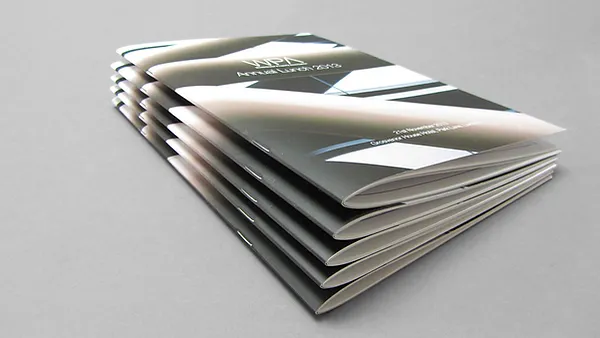
When you are looking for Magazines to Print , there are many benefits for both cost and quality. Thanks to advances in digital printing, costs have dropped over the years. This is great news for businesses wanting to print fewer catalogues. They can spend less and still get high-quality prints that impress their customers.
Cost Savings when selecting which type of Magazine to Print
One big plus of catalogue printing is saving money. Digital printing now lets businesses make smaller amounts of catalogues for a lower cost. This means they don’t have to spend a lot to get their message out. They can use the saved money for other important parts of their business.
Speed and Efficiency
Another key advantage is how fast and efficient catalogue printing can be. Digital printing means catalogues can be ready in no time, helping businesses keep up with market changes quickly. Being fast can help a company stay ahead, making sure customers always get the latest news and products.
Better Inventory and Distribution Control
By printing fewer catalogues, companies have better control over their stock and how they get distributed. They don’t need to store a ton of them, which cuts down on waste. This approach also means they can aim their catalogues at the right people, making each print more effective.








